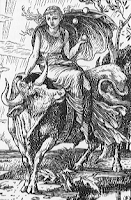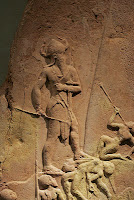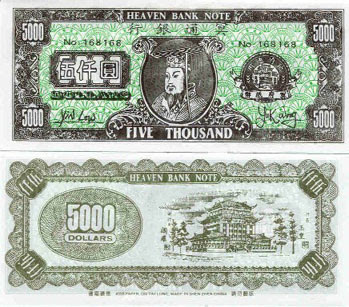"'She is so kind-hearted,' said the king; 'she might imagine it her duty to sacrifice herself to our people.'
I've spent the last few days writing down all that I've gathered up, about Woodhenge. I then indulged an old passion: that of making a web-site using nothing but Notepad and code.
There is a link to the site on the side bar, under the heading Chapters.
It isn't a chapter, but it is the workings out for a chapter!
What I'm supposed to be doing is putting Woodhenge into the context of the Persephone myth; this was easier to do before I started asking questions about Woodhenge. Before I started asking questions, I had a fairly clear version of the Neolithic and then the Bronze Age. Basically I was happy with Aubrey Burl's version of archeology. I'm also happy with the Campbell version of mythology as a kind of dialogue between man, his environment and his understanding of how things work; that a myth is a component of the instruction code required to live a civilised life with others.
I guess that will have to go, too!
I almost wish that I hadn't gone to the source, to read Maud Cunnington's excavation notes, or sat down -again using MS Paint, but then I gave up and used Flash- to check out Mr Burl's assertion that all the major finds: things such as chalk axes and enigmatic little objects sometimes called 'lamps', oh and human remains, were located in the eastern half of the henge.
Because they're not...
I mean I checked it out again and again, and it is easy to make mistakes...but the cremation in post hole C 14 and the bit of skull and teeth (C 13) were in the north end.
In the south there were pig and ox bones and arrow heads plus a piece of chalk with a hole bored into it, flint hammer, fossil Echinus and beaker. Part of human femur...In the south-west, a fragment of beaker.
In the west there was a flint axe and in what Maud believed to be the Bronze Age layer, some skull.
I can't even trust Maud for answering the question: were there any arrow heads found there. Maud also excavated The Sanctuary and did not record any significant quantity of arrow heads there...but a recent dig found plenty of arrow heads that the excavators missed. Maud makes only one mention of arrow heads at Woodhenge.
It is nice to divide Woodhenge into an area for the dead and an area for the living, or say that each deposit is pointing to an astronomical event, or say that all female burials in Wessex face sun set and all male burials to the sun rise, but it doesn't seem to be true.
Or more honestly, no one really knows...especially not me.
My contention is that the Persephone myth inclined Sir Arthur Keith to interpret Woodhenge's central burial as female. Burials in ditches seem to be male, there is evidence for that (Stonehenge, the guy shot with arrows and Woodhenge where there are enough bones to be sure). But within henge banks women and children have been found. Woodhenge's bank had long been squashed down when Maud excavated, so some of the bones she found in what she called Romano-British layers (four foot deep) may once have been within the bank.
The Woodhenge child isn't the only mythic female burial in the center of a circle though.
The other central burial is at The Sanctuary. I don't know how central this burial was, I have never been there.
I wonder if people leave flowers and other offerings there as they do at Woodhenge?
All I know is that Aubrey Burl says "By the eastern most block of the inner ring there is a concrete marker". Here a hole was dug and a girl aged somewhere between thirteen and fifteen, was crammed inside it. Her head was turned to the south. Over her body were scattered burnt animal bones, and by her knees was placed a beaker pot, perhaps full of drink to sooth her ghost.
Then a sarcen stone was pulled upright, ramming earth, chalk and rubble over her.
In this way she was sealed underground...
After a few thousand years after, Maud Cunnington dug her up and after trying to glue her skull back together. Maud sent her bones on to Sir Arthur Keith. After he judged the bones to have belonged to a girl aged fifteen years, he sent her to London. Her bones are now, like the man they found at Durrington (and called a fine specimen of a man...) the man in the Woodhenge ditch and the guy squashed by a Sarcen at Avebury, all are preserved (albeit in cardboard boxes) in the National History museum.
There is another account of the Woodhenge excavation that I should track down; but as I keep saying, I don't now how far into this I want to go. For instance I didn't make a note of cattle horn remains in the post holes, because there are over one hundred post holes at Woodhenge and so I only made a note of post holes that contained the things Aubrey Burl had noted as significant; because I was using his theory as my starting point.
Cattle are very significant.
At the moment it is logical to believe that cattle were the preferred offering to the dead, there is plenty of correlations between tombs and cattle bone.
Myth is full of cattle, of girls making promises to bulls, folk tales too (folk tales are often half remembered myth embroidered into a new and sparkling tale) .
My personal favorite is "The Brown Bull of Norrowa".
There is a link to the site on the side bar, under the heading Chapters.
It isn't a chapter, but it is the workings out for a chapter!
What I'm supposed to be doing is putting Woodhenge into the context of the Persephone myth; this was easier to do before I started asking questions about Woodhenge. Before I started asking questions, I had a fairly clear version of the Neolithic and then the Bronze Age. Basically I was happy with Aubrey Burl's version of archeology. I'm also happy with the Campbell version of mythology as a kind of dialogue between man, his environment and his understanding of how things work; that a myth is a component of the instruction code required to live a civilised life with others.
I guess that will have to go, too!
I almost wish that I hadn't gone to the source, to read Maud Cunnington's excavation notes, or sat down -again using MS Paint, but then I gave up and used Flash- to check out Mr Burl's assertion that all the major finds: things such as chalk axes and enigmatic little objects sometimes called 'lamps', oh and human remains, were located in the eastern half of the henge.
Because they're not...
I mean I checked it out again and again, and it is easy to make mistakes...but the cremation in post hole C 14 and the bit of skull and teeth (C 13) were in the north end.
In the south there were pig and ox bones and arrow heads plus a piece of chalk with a hole bored into it, flint hammer, fossil Echinus and beaker. Part of human femur...In the south-west, a fragment of beaker.
In the west there was a flint axe and in what Maud believed to be the Bronze Age layer, some skull.
I can't even trust Maud for answering the question: were there any arrow heads found there. Maud also excavated The Sanctuary and did not record any significant quantity of arrow heads there...but a recent dig found plenty of arrow heads that the excavators missed. Maud makes only one mention of arrow heads at Woodhenge.
It is nice to divide Woodhenge into an area for the dead and an area for the living, or say that each deposit is pointing to an astronomical event, or say that all female burials in Wessex face sun set and all male burials to the sun rise, but it doesn't seem to be true.
Or more honestly, no one really knows...especially not me.
My contention is that the Persephone myth inclined Sir Arthur Keith to interpret Woodhenge's central burial as female. Burials in ditches seem to be male, there is evidence for that (Stonehenge, the guy shot with arrows and Woodhenge where there are enough bones to be sure). But within henge banks women and children have been found. Woodhenge's bank had long been squashed down when Maud excavated, so some of the bones she found in what she called Romano-British layers (four foot deep) may once have been within the bank.
The Woodhenge child isn't the only mythic female burial in the center of a circle though.
The other central burial is at The Sanctuary. I don't know how central this burial was, I have never been there.
I wonder if people leave flowers and other offerings there as they do at Woodhenge?
All I know is that Aubrey Burl says "By the eastern most block of the inner ring there is a concrete marker". Here a hole was dug and a girl aged somewhere between thirteen and fifteen, was crammed inside it. Her head was turned to the south. Over her body were scattered burnt animal bones, and by her knees was placed a beaker pot, perhaps full of drink to sooth her ghost.
Then a sarcen stone was pulled upright, ramming earth, chalk and rubble over her.
In this way she was sealed underground...
After a few thousand years after, Maud Cunnington dug her up and after trying to glue her skull back together. Maud sent her bones on to Sir Arthur Keith. After he judged the bones to have belonged to a girl aged fifteen years, he sent her to London. Her bones are now, like the man they found at Durrington (and called a fine specimen of a man...) the man in the Woodhenge ditch and the guy squashed by a Sarcen at Avebury, all are preserved (albeit in cardboard boxes) in the National History museum.
There is another account of the Woodhenge excavation that I should track down; but as I keep saying, I don't now how far into this I want to go. For instance I didn't make a note of cattle horn remains in the post holes, because there are over one hundred post holes at Woodhenge and so I only made a note of post holes that contained the things Aubrey Burl had noted as significant; because I was using his theory as my starting point.
Cattle are very significant.
At the moment it is logical to believe that cattle were the preferred offering to the dead, there is plenty of correlations between tombs and cattle bone.
Myth is full of cattle, of girls making promises to bulls, folk tales too (folk tales are often half remembered myth embroidered into a new and sparkling tale) .
My personal favorite is "The Brown Bull of Norrowa".


